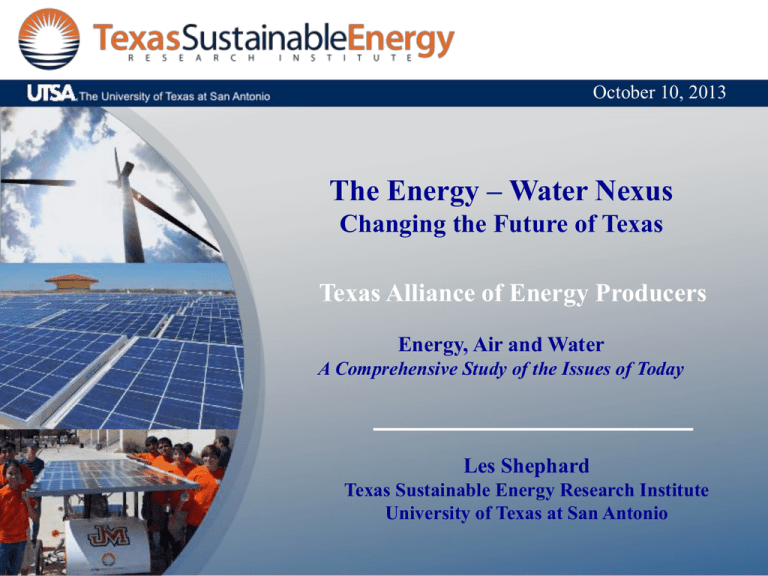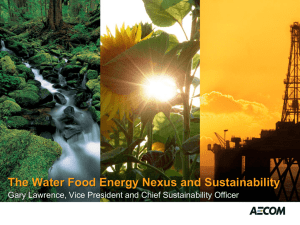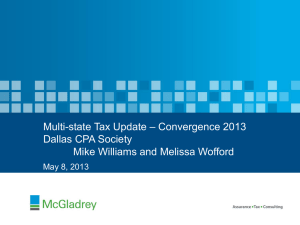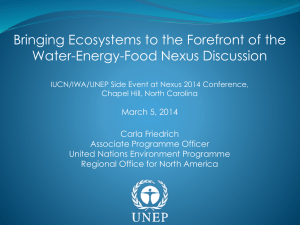Water - Texas Alliance
advertisement

October 10, 2013 The Energy – Water Nexus Changing the Future of Texas Texas Alliance of Energy Producers Energy, Air and Water A Comprehensive Study of the Issues of Today Les Shephard Texas Sustainable Energy Research Institute University of Texas at San Antonio Water Water Everywhere! Water Treatment Expensive ….. So….. AND What Energyisis Intensive! the Problem? Energy – Water Nexus A Global Context Future Freshwater World Population Needs World Electricity Demand 6000 7 35000 30000 5 4 Millions of Megaliters Withdrawn 8 Billions of kilowatt-hours Global population 7000 6 Billions Population living under severe water stress 9 25000 20000 15000 3 10000 2 5000 0 1 2010 0 2005 Courtesy IEEE Spectrum, July 2010 2030 2015 5000 Expected shortfall 4000 Municipal and domestic 3000 Industry 2000 Agriculture 1000 0 2020 -1000 -2000 2010 2030 2030 2025 2030 Our Water Future Will Rely on Non -Traditional Water Resources Produced Water From Oil and Natural Gas Production Gas Production Oil Production Mixed Production Dry Wells Major Inland Brackish Water Resources U.S. Saline “Brackish” Aquifers Our Energy Future Will Also! Source: Mast, et al., 1998, (on left); USGS, (on right) Projected Water Use of Non-Traditional Water (BGD) Growing Demand for Non-Traditional Water Resources 20 Waste Water Reuse Desalination Power Requirements For Treating Today 15 The Future 10 5 Conventional Treatment 1990 2000 2010 Brackish Nanofiltration Brackish Reverse Osmosis Sea Water Reverse Osmosis 2020 Year • Desal increasing ~ 10% per year • Waste water reuse increasing ~ 15% per year ……. AND Growing! Sources: EPA 2004, Water Reuse 2007, Mickley 2003; Einfeld 2007 The U.S. Energy Future The Energy – Water – Carbon “Trifecta” (Kilograms per Kilowatt-Hour) Carbon 1.0 Open Loop Cooling Closed Loop Cooling US Electricity Generation By Source COAL 0.8 Petroleum Renewables 9% 2% Other 1% 0.6 Coal 45% Nuclear 19% Natural Gas 24% 0.4 NATURAL GAS Closed Loop Cooling 0.2 PHOTOVOLTAIC 0 WIND GEOTHERMAL NUCLEAR 1 Source: Lux Research, June 2009 Global Energy: Unshackling Carbon from Water 2 SOLAR THERMAL 3 4 Water Consumed (Liters per Kilowatt-Hour) HYDROELECTRIC 5 6 Water Challenges are Complex and Highly Interdependent Competing Sectors Energy Water Supply Secure Reliable Demand Economic Prosperity Regulatory/P olicy Framework Growth Productivity Development Cost Technology Innovation Environmental Stewardship Infrastructure Endangered Species Land Use Water Life Cycle Climate (Drought) All Three Imperatives Must Be Addressed!! Freshwater Withdrawal by Sector* (~ 345 BGD in US) Public Supply 14% Thermoelectric Power 39% Source: USGS Circular 1268, March 2004 * *Does not include hydropower Industrial Livestock 6% 2% Irrigation 39% Freshwater Consumption by Sector (~ 100 BGD) Non-Ag Sector Consumption Freshwater Consumption Livestock 3.3% Irrigation 80.6% Non-Ag 16.1% Domestic 7.1% Industrial 3.3% Commercial 1.2% Mining 1.2% Thermoelectric 3.3% Energy Accounts for ~ 27 Percent of Non-Agricultural Fresh Water Consumption Source: USGS, 1998 The Nexus in Texas! TexasAConsumes Diversified~ Energy 157 Billion – Water Gallons Portfolio of Water Is Key to Produce ~ 400 Billion SankWh Antonio Annually Is Charting – MoreItsThan Future! Any Other State! CPS Energy Sources Electricity Demand AND …… Texas Electricity and Water Demand Projected to Increase! Source: Report on the Capacity, Demand, and Reserves in the ERCOT Region, May 2010; CPS Energy - SAWs Energy Water Nexus, April 2011; Texas Water Development Board Water Demand SAWS Sources Strategic Move Toward Recycled Water Water Use by CPS Energy - 1962 to 2010 Creating a Sustainable Energy – Water Future! Total groundwater used Total surface water used 2020 Cumulative Water Reduction Impact CPS Energy 2020 Vision Goal Acre 1500 Feet MW of Renewable Energy Generation 64,000 acre-feet (21 Billion Gallons) 100 MW Non-Wind Generation 18,000 acre-feet (6 Billion Gallons) AMI and Smart Grid Roll-out Increasing Energy Efficiency Will Further Reduce Water Use Years Courtesy CPS Energy - SAWs Energy Water Nexus, April 2011 The Nexus in Texas It Ain’t A Line Dance! Percentage Water Wells Related Oil and (est.) Locationofof “Fracing” Sites to – 2005 toGas 2009 SOURCES Leonard Dougal – Jackson Walker New York Times – Citing UT Bureau Economic Geology IHS Database National Drought Mitigation Center NOAA USDA TCEQ – Office of Water “Shale Production” “Contributing To A Low Carbon, Energy - Water Future?” Water Technology Innovation and Data Critical Sustainable Development Is Are Critical Water Supply – Economic Prosperity – Responsible Environmental Stewardship • Water Treatment Innovation – low energy and low water consumption technologies – improved “waterless “smart • “Value of Water” strategy - membranes, Considers costs of reusefracing”, treatment, energy, technologies”, selectivedisposal water use, etc transport, concentrate VERSUS direct disposal and trucking. Roads, emissions, safety, etc. are externalities. Recognize not all fluids are • Efficacy of Water Reuse is dependent on water quantity, water quality and treatable – coupled with regional water strategy flow duration. Economics will likely drive decision AND overall water strategy • Water Life Cycle Systems Analyses – promote sustainable development through systems analyses focused on the “Long View” for water – fresh • Water are sparse, error-prone and inconsistent across US – make it andData brackish a priority AND readily available! Source: EIA, March 2010 Energy and Water are Inextricably Linked! Water For Energy Energy and Power Production Require Water • Thermoelectric Cooling • Hydropower • Energy Minerals Extraction and Mining • Fuel Production (Fossil Fuels, H2, Biofuels) • Emission Control Energy For Water Water Production, Processing, Distribution, and End-use Require Energy • • • • • Pumping Conveyance and Transport Treatment Use Conditioning Surface and Groundwater Energy With Sufficiently Abundant, Clean and Affordable Water Water Problems Can Be Solved Our Energy Eagle Ford Shale – Keeping The Lights On …. AND ….. Hopefully the Water Running!! Picture courtesy of Dr. Tom Tunstall – Institute for Economic Development - UTSA http://www.businesswire.com/news/home/20130328005282/en/UTSA-Releases-Updated-Eagle-Ford-Shale-Economic Educating Tomorrow’s America --- Today! The University of Texas at San Antonio











